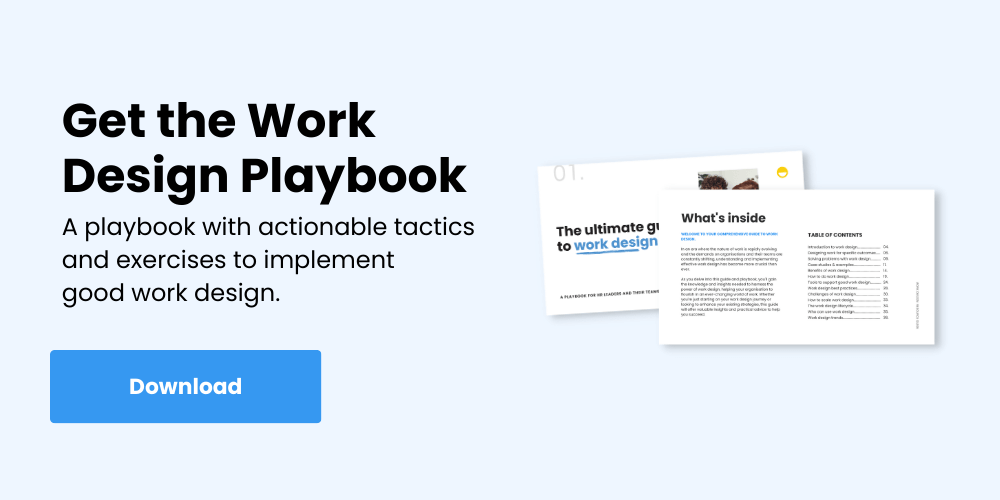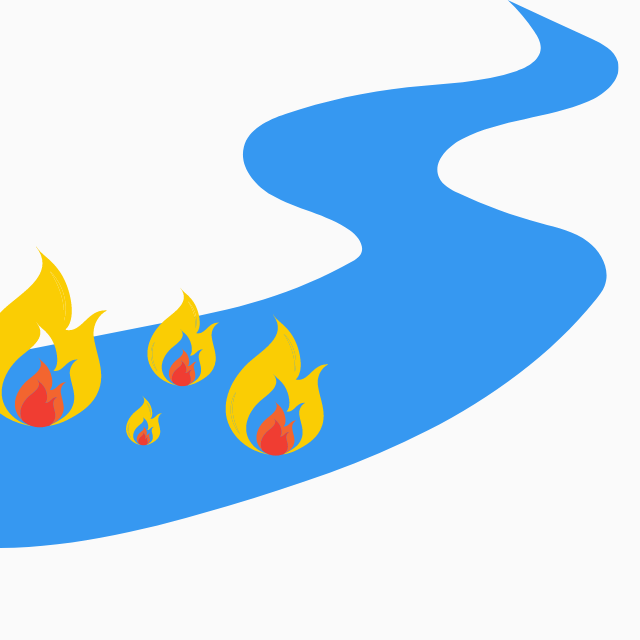Introduction
In the ever-evolving landscape of modern workplaces, the concept of work design has emerged as a pivotal factor in enhancing productivity, job satisfaction, and overall organizational success. How to implement good work design is not just a matter of operational necessity but also a strategic tool that shapes the way we work, collaborate, and achieve business goals.
In this comprehensive guide, I will explore the multifaceted aspects of work design, focusing on themes such as finding efficiencies and risks, embracing organizational design best practices, navigating the nuances of job crafting, and mastering the art of
activity analysis. These components are critical in fostering a workplace environment where every role is structured not only for efficiency and effectiveness but also for the fulfillment and growth of the individual.
As we delve into these themes, remember that good work design is not a one-size-fits-all solution. It’s a dynamic process, tailored to fit the unique needs and goals of each organization and its employees. Whether you’re a business leader, HR professional, or an employee seeking to enhance your work experience, this guide aims to equip you with practical insights and strategies to transform the way work is designed and executed in your organization.
Join me on this journey to discover how to implement good work design, a crucial step towards creating more engaging, productive, and fulfilling workplaces.
Understanding Work Design
At its core, work design is the methodical arrangement of job tasks, responsibilities, and processes to optimize the employee experience and maximize organizational effectiveness. It’s about shaping the job roles in a way that aligns with both the individual’s skills and the strategic objectives of the organization.
In today’s fast-paced business world, the significance of work design cannot be overstated. It goes beyond mere job descriptions; it’s about creating roles that are both efficient and fulfilling.
A well-designed job can:
- increase employee engagement
- reduce turnover
- lead to higher job satisfaction
It ensures that employees are not just cogs in a machine, but integral parts of the organizational mechanism, each contributing uniquely to the larger goals.
Furthermore, work design is critical in addressing the challenges of the modern workplace, which include:
- rapid technological changes
- evolving employee expectations
- growing need for work-life balance
By understanding and implementing effective work design, organizations can create flexible, resilient, and adaptive work environments that are prepared for the challenges of both today and tomorrow.
In the following sections, we will explore how to harness efficiencies, mitigate risks, and apply best practices in organizational design, along with insights into job crafting and activity analysis, to elevate the standard of work design in your organization.
Benefits of Implementing Good Work Design
Implementing good work design practices brings a multitude of benefits to both organizations and employees.
Organizational Efficiency
It leads to increased efficiency by ensuring that employees’ roles are optimally aligned with organizational goals and their personal skills. This alignment not only boosts individual productivity but also contributes significantly to the overall operational efficiency of the organization.
Increases in Employee Engagement and Job Satisfaction
Firstly, it significantly boosts employee engagement and job satisfaction by aligning their roles with their skills and interests. This alignment not only enhances individual productivity but also contributes to overall organizational efficiency.
Healthier Workplace Environments
Good work design also fosters a healthier workplace environment by reducing stress and preventing burnout, leading to improved mental and physical well-being of employees.
Culture of Innovation and Adaptability
Additionally, it supports a culture of innovation and adaptability, crucial in today’s fast-paced and ever-changing business landscape.
By embracing good work design, organizations can expect a more committed, productive, and resilient workforce, driving sustainable business success.
Efficiencies and Risks in Work Design
In the realm of work design, balancing efficiencies and risks is akin to walking a tightrope. Achieving this balance is crucial for fostering a productive and safe workplace.
Maximizing Efficiencies:
Efficiency in work design is about optimizing processes and roles to achieve maximum productivity with minimum wasted effort or expense. This involves streamlining tasks, eliminating redundancies, and leveraging technology for automation where appropriate. It’s also about aligning employee skills with their job roles, ensuring that each individual is positioned to contribute optimally.
Identifying and Mitigating Risks:
Conversely, risk management in work design involves identifying potential hazards and implementing strategies to mitigate them. These risks can range from physical safety concerns in the workplace to psychological risks such as job burnout.
Effective risk management includes regular assessment of work processes, employee feedback, and staying abreast of industry best practices. It also involves fostering a culture of safety and well-being, where risks are openly discussed and addressed.
In the following sections, we’ll delve deeper into organizational design best practices, the art of job crafting, and the techniques of activity analysis, each playing a vital role in achieving this delicate balance between efficiency and risk in work design.
Best Practices in Organizational Design
Organisational design is a strategic framework that aligns the structure of a company with its objectives and resources. Implementing best practices in organizational design is key to achieving operational excellence and sustainable growth.
Clarifying the Organizational Structure
This involves defining clear roles, responsibilities, and reporting relationships. Many organisations don’t have an easy, efficient way to get a snapshot of this landscape. A well-structured organization enhances communication, streamlines decision-making, and ensures accountability.
Aligning Design with Business Goals
The structure of an organization should mirror its strategic objectives. Whether it’s a flat, hierarchical, or matrix structure, the design must support the company’s long-term goals and operational needs.
Fostering Flexibility and Adaptability
In today’s dynamic business environment, organizational designs need to be flexible. This allows companies to respond rapidly to market changes, technological advancements, and evolving customer needs.
Promoting Collaboration and Innovation
Encouraging cross-functional teams and open communication channels fosters a culture of collaboration and innovation. This approach can lead to more creative solutions and a more cohesive organizational culture.
Continuous Evaluation and Improvement
Organizational design is not a set-and-forget strategy. Regularly assessing the effectiveness of the current structure and making necessary adjustments is essential for sustained success.
Incorporating these best practices in organizational design is a fundamental step towards creating a robust and efficient workplace that thrives in the face of challenges and opportunities alike.
Tip: Beamible can help simplify and digitise the org design processes you’re already doing every day. Learn more
Role Design: Crafting Effective Job Roles
Role design is an essential element of work design, focusing on tailoring job roles to maximize both organizational efficiency and employee satisfaction. It’s about creating roles that not only meet the needs of the organization but also leverage the strengths and aspirations of the employees.
Alignment with Organizational Goals
Effective role design begins with aligning job roles with the strategic objectives of the organization. This ensures that each role contributes directly to the broader mission and goals.
Balancing Flexibility and Structure
While roles should have clear responsibilities and expectations, they also need a degree of flexibility to adapt to changing conditions and to accommodate employee growth and development.
Fostering Employee Engagement
Designing roles that are challenging, fulfilling, and meaningful can significantly boost employee engagement. This includes considering employee skills, interests, and career aspirations in the role design process.
Encouraging Professional Development
Well-designed roles provide opportunities for professional growth, encouraging employees to develop new skills and advance in their careers.
Regular Review and Adaptation
Roles should be periodically reviewed and adapted as necessary to respond to organizational changes, employee feedback, and evolving market demands.
By focusing on these aspects, role design becomes a powerful tool in creating a work environment where employees are motivated, engaged, and aligned with the company’s vision.
Tip: Beamible was built to make role design simple, easy, and dynamic, reducing the need for clunky and annoying spreadsheets
Mastering Activity Analysis
Activity analysis is a critical component of effective work design, focusing on the examination and optimization of the tasks and processes within a job role.
Identifying Core Activities
The first step is to identify the key activities that constitute a job role. This involves breaking down the role into its essential tasks and responsibilities.
Evaluating Task Significance
Assessing the importance and impact of each task on overall job performance is crucial. This helps in prioritizing tasks and allocating resources effectively.
Time and Motion Studies
Analyzing how time is spent on various activities can reveal inefficiencies and opportunities for improvement. It can also help in balancing workloads.
Employee Feedback
Involving employees in the activity analysis process is vital. Their insights can provide valuable information on challenges and potential improvements in their daily tasks.
Continuous Improvement
Activity analysis is not a one-time exercise. Regular review and adjustment of tasks and processes ensure that job roles remain relevant and efficient.
By mastering activity analysis, organizations can optimize job roles for better performance, employee satisfaction, and overall organizational efficiency.
Tip: Beamible is a, easy, cost-effective solution to activity analysis that can achieve the same outcomes to an expensive, lengthy consulting engagement - a great alternative when budgets are limited
Conclusion
In this guide, we have navigated the intricate landscape of good work design, exploring its various facets including efficiencies and risks, organizational design best practices, the importance of role design, and the nuances of activity analysis. Each element plays a vital role in shaping a work environment that is not only productive and efficient but also fulfilling and adaptable.
Implementing good work design is a journey of continuous improvement and adaptation. It requires a thoughtful blend of strategic planning and personalization, ensuring that job roles are not only aligned with organizational goals but also resonate with employee aspirations and strengths.
As we embrace these principles, we open the doors to a workplace that is dynamic, engaging, and primed for both individual and collective success. The path to excellent work design is an ongoing one, and I encourage you to take these insights and apply them in your organization, continually seeking ways to refine and enhance the way work is structured and experienced.
Remember, the ultimate goal of good work design is to create a work environment where every individual can thrive and contribute to their fullest potential.






